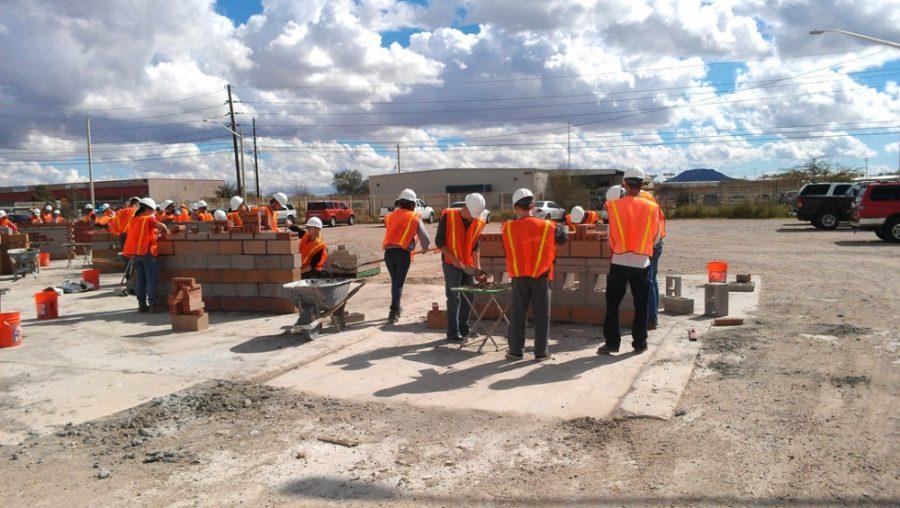Certain elements of being an architect cannot be taught in the classroom — it takes first-hand experiences.
On Tuesday, 53 students in the UA’s College of Architecture, Planning & Landscape Architecture gained some of that first-hand experience and completed the construction of their own masonry walls. The students were split into groups and built walls measuring 32 square feet, which are located in the yard of the Superlite Block Company.
Through masonry construction, ”students … experience first-hand the value of developing relationships with the contractors and on-the-job tradespeople, who are also an important part of the design and construction team,” said Ray Barnes, School of Architecture lecturer and coordinator of the wall-building program.
Barnes coordinated the wall-building program for the past five years with Martin Pagnotta and Mary Hardin. Pagnotta was involved with the Superlite Block Company in 2001, and Hardin is a current UA professor.
“Another aspect of what the students learn is how to function as a high-performance team, which is the way architectural projects are managed in real life,” Barnes said.
The wall-building program encourages students to work as a team.
“Every year, the students impress us with new ideas, … wall forms … we have not seen in past years,” Barnes said. “These are creative young architects. … Sometimes the wall designs are so special that the designs are admired, if not actually ‘borrowed,’ by some of the currently practicing architects.”
Tyler Rodriguez, an architecture junior, is currently enrolled in Barnes’ course.
“[It] is very important to get out there and see what you are going to be building,” Rodriguez said. “… You learn little intricacies that you don’t learn sitting in a classroom.”
Rodriguez also emphasized Barnes’ direct approach to teaching.
“He gives us many opportunities to make mistakes and learn,” he said.
Elena Vargas, an architecture sophomore, said she went into the design and construction process with an open mind.
“I had no construction experience,” Vargas said. “… This experience has been extremely educational because it is entirely hands-on.”
Vargas said her team’s design was intentionally minimalist. Because of their lack of experience, her team members wanted to focus on the quality of construction and mastering the basics, like how to spread mortar and lay blocks.
“We are still far from being able to call ourselves master masons,” Vargas said, noting that her team, however, is “far more proficient now than we were just a few weeks ago.”
Di Le, a junior and second-year architecture student, said he realized the hard work that goes into architecture. Le said the idea behind his wall was focused on “the modular sizes of the blocks.”
Despite some miniscule errors, Le said his design was executed as planned. He added that this type of hands-on learning is very valuable, as students sometimes “get caught up with just designing … or being in this conceptual stage, rather than trying out the task.”
Jennifer Lee Ingram, an architecture sophomore, said her team’s design was inspired by elegance and subtle changes in depth and material.
“It has been more difficult than I expected,” Ingram said. “… I have much more respect for people working [in this industry].”
She added that wall construction takes a lot of skill, patience and strength.
“Regardless of where one studies to be an architect,” Barnes said, “most of us believe there is no better education to promote thinking, design, and problem solving — an important characteristic trait of those who are successful in any career.”
_______________
Follow Terrie Brianna on Twitter.









